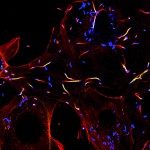Link to Pubmed [PMID] – 16214316
Curr. Opin. Immunol. 2005 Dec;17(6):662-9
The aggregation of high-affinity IgE receptors (FcepsilonRI) on mast cells and basophils has long been known as the critical event that initiates allergic reactions. Monomeric IgE was recently found to induce a variety of effects when binding to FcepsilonRI. Upregulation of FcepsilonRI only requires binding, whereas other responses require FcepsilonRI aggregation. Interestingly, FcepsilonRI aggregation has recently been understood to generate a mixture of positive and negative intracellular signals. Mast cells and basophils also express low-affinity and, under specific conditions, high-affinity IgG receptors. When co-engaging these receptors with FcepsilonRI, IgG antibodies can amplify or dampen IgE-induced mast cell activation. On the basis of these findings, it has been proposed that FcRs can be used as targets and/or tools for new therapeutic approaches to allergies.
